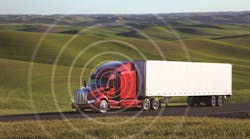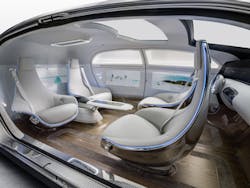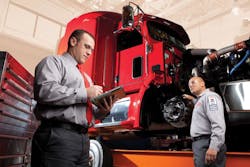If you long for the days when trucks were just trucks, when they were mechanical beasts you could use hand tools to keep up and running – without all the electronic geegaws we find on them today – it’s pretty much time to kiss those days goodbye: So long, farewell, auf Wiedersehen, good night.
[Good lord, did I just make a reference to The Sound of Music? What the heck was in my coffee?]
From purely an air pollution perspective, much less one focused on fuel economy, trucks needed to evolve into big rolling computers in order to maximize efficiency.
But here’s the kicker: so-called “connected trucks” are also going to provide an avenue for growing revenue for not only truck makers but for light vehicle manufacturers as well.
Take a look at the 2017 KPMG Global Automotive Executive Study, compiled by KPMG research, which polled nearly 1,000 executives across a range of global automotive companies. That survey found 76% believe just one connected car can generate more “revenue streams” than 10 conventional cars – and , in fact, their expectations for data-driven revenue are so great that 71% of those executives believe, going forward, measuring “market share” based on the number of units sold will be an “outdated” way of gauging market dominance.
"The game has changed for automakers, as cars have evolved into rolling computers and consumers have been quick to embrace autonomy, connectivity and mobility-on-demand," noted Gary Silberg, KPMG's automotive sector leader, in the report.
"A car is no longer defined by its utility, it is defined by the experience it provides to the driver and passenger – and that opens a tremendous pipeline for new revenue streams and business services that we project could top $1 trillion in the next decade or so," he stressed.
Indeed, 80% of executives polled by KPMG for its study agreed that data will be the “fuel” for future business models, with 83% believing they will make money off of that data.
On top of that, in order to create value and consequently monetize data, 82% of the executives agree that a car needs its very own ecosystem/operating system as otherwise the valuable consumer and/or vehicle data will be most likely routed through third parties – meaning vehicle OEMs might lose out on what Silberg termed “valuable revenue streams.”
Sandeep Kar, global vice president for research and mobility at Frost & Sullivan, noted that this very same point applies to heavy truck manufacturers as well – and for many of the same reasons.
“Connectivity is required between the commercial vehicle that carries the freight, which goes into warehouses and then is used to deliver value-added services,” he explained in a conference call late last year.
“That has been the missing link for many years. For far too long, the industry has focused on the powertrain, chassis, safety-related technology, [plus] comfort and convenience technologies,” Kar stressed. “Finally, now, we are seeing the true advent of connecting with telematics and related technologies that can offer a multitude of benefits to not only the end-users but also the owners and operators of these vehicles.”Kar said the “inevitable” rise of digitization in trucking is expected to bring significant changes to the way freight is moved today as flexibility, mobility, and real time demands increase. As a result, he added, data security and 24/7 customer support will be necessary.
KPMG’s Silberg echoes that point, noting that both executives and consumers polled in his firm’s survey agree that data security and privacy are “top purchasing criteria” for the self-driving age where passengers are interacting with the car's digital platform.
“You cannot overstate the importance of data security in the autonomous era,” he stressed. “The massive amount of data that is being collected presents a tremendous business opportunity for auto companies. Addressing information security concerns is a critical priority for automakers – and one they cannot afford to get wrong."
Of course, executives and consumers don't see eye-to-eye regarding who should own that consumer and vehicle data, Silberg pointed out, noting that in KPMG’s study, automotive executives are split between thinking OEMs (31%) and consumers (27%) should own the data, while consumers overwhelmingly believe only they should own it.
But that is almost beside the point, stressed Frost & Sullivan’s Kar, for the main factor is that, central to all of these things, is to connect the vehicle to the world outside and the world outside to the vehicle.
For that reason, location-based services will take on even greater importance, he said.
Think on these numbers for a minute: in 2010, there were about 12.5 billion connected devices globally, and of those, only about 870 million were location-based devices. But by 2020, Frost & Sullivan projects that connected devices will increase to 50 billion, with location-based service devices increasing to 22 billion, which means they will represent 44% of all connected devices.
“That makes vehicle connectivity that much more important, because the vehicle will be central in ensuring that stuff is delivered on time every time,” Kar emphasized.
He added that while 61% of all connected vehicles will belong to the light commercial vehicle category used in urban settings, the remaining 39% will reside in the medium- and heavy-duty segment.
“And we’re only looking at the tip of the iceberg,” Kar explained. “Fuel management, driver management, and vehicle management are driving revenues of about $3.5 billion today, but what we do not see is what lies under the surface which is ten times as big.”
By that he means that what we’re seeing today in terms of the services available through connected trucks are “revenue generators,” but what lies under the surface are “profit generators” for OEMs.
“When warranty optimization, order management, prognostics, driver behavior and training, transportation management services, usage based insurance, and automated driving start to rise and become available, that is when the real profit drivers will be exposed,” Kar stressed. “It’s just a matter of time.”






